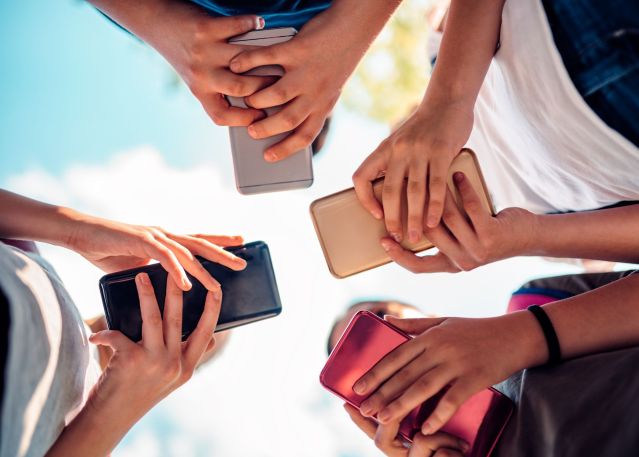Many parents feel that their children’s increased use of technology and high exposure to social media make parenting more difficult than it was only a couple of decades ago. Most parents have a sense that there are risks involved with giving a smartphone to children younger than 11, possibly ones that will negatively affect their social skills and distract them from their school responsibilities. But, before drawing these conclusions, parents need a more accurate understanding of the technology and social media landscapes. What follows are highlights from recent data on technology and social media use in youth.

Source: kerkez/Getty Images
Usage
According to a study by the Pew Foundation, 48 percent of parents with children under the age of 5 say their children interact with tablet computers and 55 percent with smartphones. Not surprisingly, usage increases as the child ages, with 80 percent of children between 5 and 11 interacting with tablet computers and 63 percent in that age group interacting with smartphones. Among teens, the time they spend using technology is even greater. While there seems to be a different age threshold for when parents tend to allow their children access to different devices, all of the devices allow access to the Internet. And the Internet gives us access to the entire world, far beyond our neighborhoods and communities.
A recent Gallup poll says that half of teens report spending at least 4 hours daily on social media like TikTok, Instagram, Facebook, and Twitter. Older teens spend more time online than younger teens, ranging from 4 to almost 6 hours per day. And girls spend nearly an hour more daily on social media than boys (5.3 vs. 4.4 hours, respectively).
The research supports what many parents might imagine—that there are pros and cons to children’s interactions with technology. But if a child spends 4 hours a day on social media, that’s 4 hours they are not interacting with family members or friends in person and time they are not spending on schoolwork. Many kids today are juggling school responsibilities with outside activities, so adding in those hours on social media could significantly encroach on sleep, studies, and the development of in-person, real-time relationships.
The Good
For young people in groups that are most at risk of being alienated (e.g., LGBTQ+, neurodivergent, and other underrepresented groups), virtual connections can provide a way to feel less alone. Online communication enables these kids to connect with other kids it might be harder to interact with openly face-to-face. It also facilitates validation, which is key to secure development.
For children with social anxiety, virtual connections and the controlled exposure they allow may take the edge off the demands of social interactions by decreasing their intensity. It’s easier to connect virtually for 10 or 15 minutes and then end the interaction than to meet up with someone only to interact with them in person for that amount of time. So, while in-person practice might teach kids more about reading body language, facial expressions, and voice tone, virtual communication can make kids feel braver about taking steps toward others. Virtual connections also give children more opportunities to interact with one another, thus giving them more practice with certain social skills.
The Bad
Despite these advantages, there are elements of social media that some parents fear. And research validates parental concerns about their children’s vulnerability. Teens are particularly susceptible, especially girls, both earlier and for a longer period than boys. During adolescence, areas of the brain associated with the desire for attention, feedback, and peer validation are more sensitive. Among girls, this period is between the ages of 11 and 13, and among boys, the period is between the ages of 14 and 15. It also seems that the more we use social media, the lower our satisfaction with life becomes. These are the years, therefore, during which parents might need to be most sensitive to their children’s use of social media.
Many parents worry about the content their children may be exposed to while scrolling through social media or surfing the Internet. Some parents are concerned about social comparisons their children may make, especially regarding body image and weight. Only about a year ago, it came to light that Instagram algorithms presented teen girls who interacted with fitness content with repeated information about how they could lose weight. This kind of messaging can lead to disordered eating behaviors like excessive dieting and purging, as well as depressive thoughts.
The Ugly
Another consequence of widespread access to social media and electronic messaging is the rise in cyberbullying, and most children today report having been cyber-bullied at least once. Before cell phones, people would talk directly to other people to spread rumors about someone, but now that these messages can be sent electronically and to multiple people simultaneously, they can potentially be received and spread virally in seconds. In addition, the act of sending electronic messages—whether via texts, email, or direct messages within apps—has no immediate repercussions for the senders and can even be done anonymously, lowering the sender’s inhibitions about checking their behavior before hitting “Send.”
Social Media Essential Reads
More than half the parents of children under the age of 11 worry about online predators and the availability of material on the Internet that they would not want their kids exposed to before a certain age. This is why it is important for parents to have conversations with their children about the existence of age-inappropriate content and to curb their children’s ability to use technology without restrictions. The Web gives access to everything out there in the world, so every child with enough curiosity can potentially be exposed to sexually explicit, violent, or hate-filled content that parents would never want them to encounter. Remember, too, that even if you restrict Internet usage in your home, your child has friends who have access to technology, so parental fears around these issues are understandable.
Because more than 4 billion people worldwide use social media, it would be naïve to imagine that U.S. teens and preteens with access to technology are not going to have some upsetting or damaging encounters with the available media. My next post will deal with what parents can do to help their kids navigate social media and the Internet in healthy ways.
